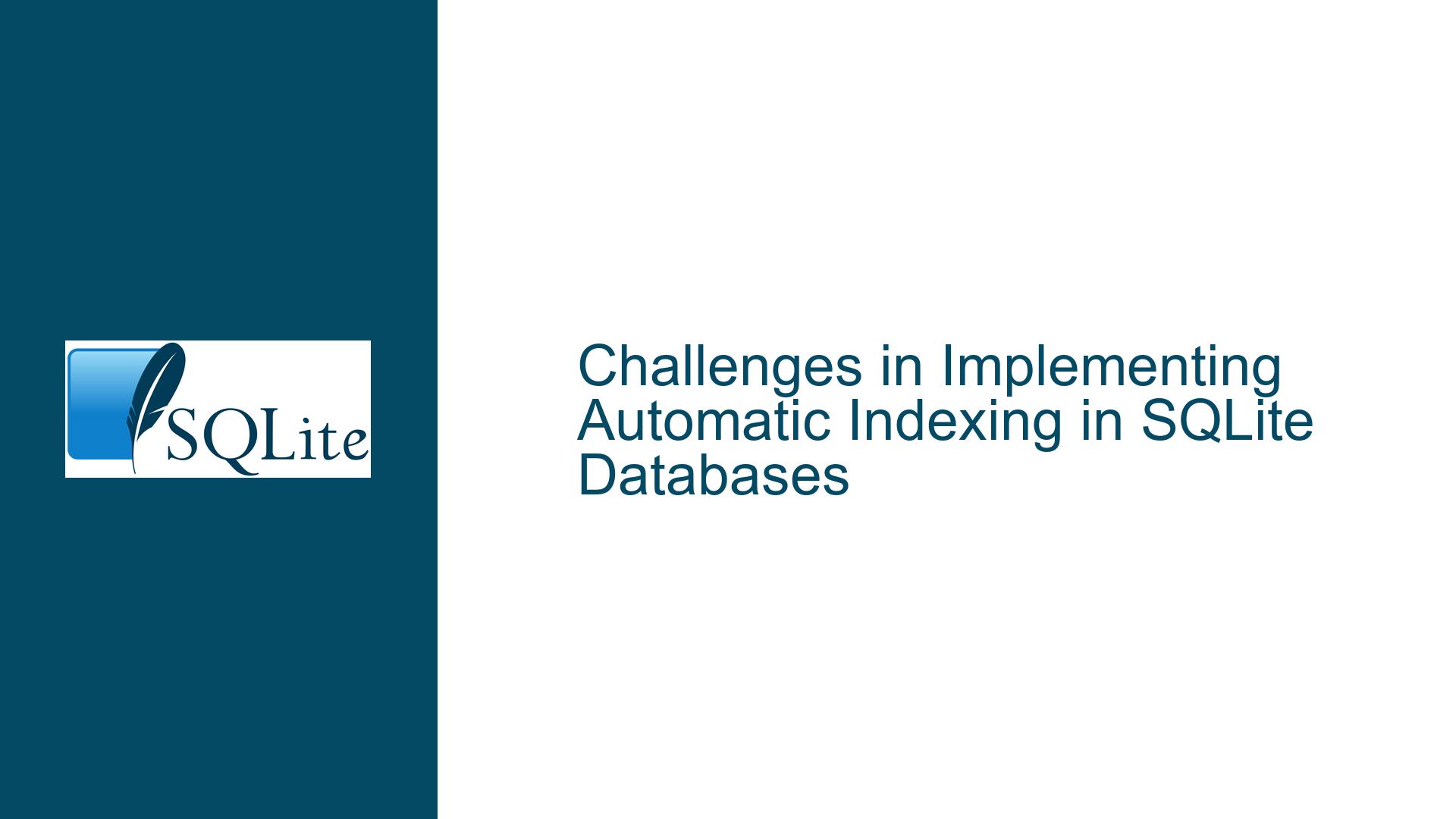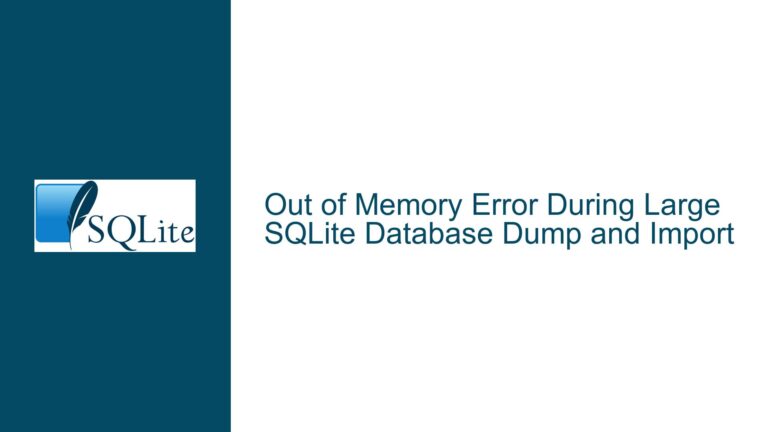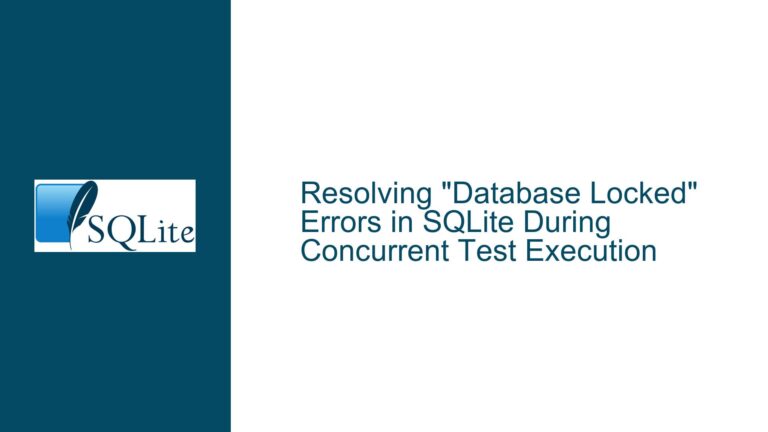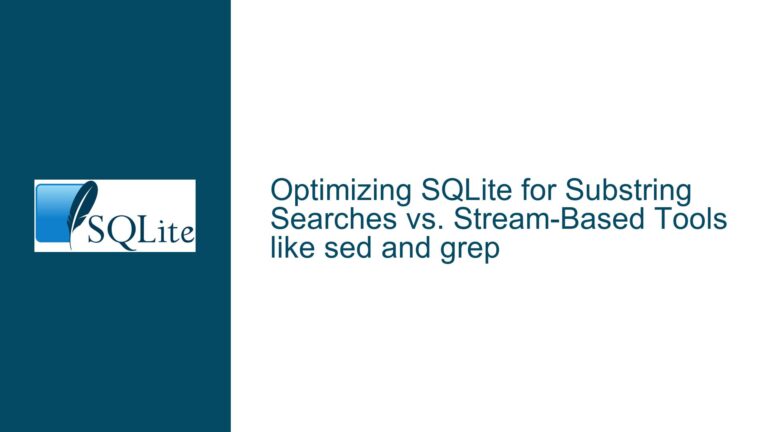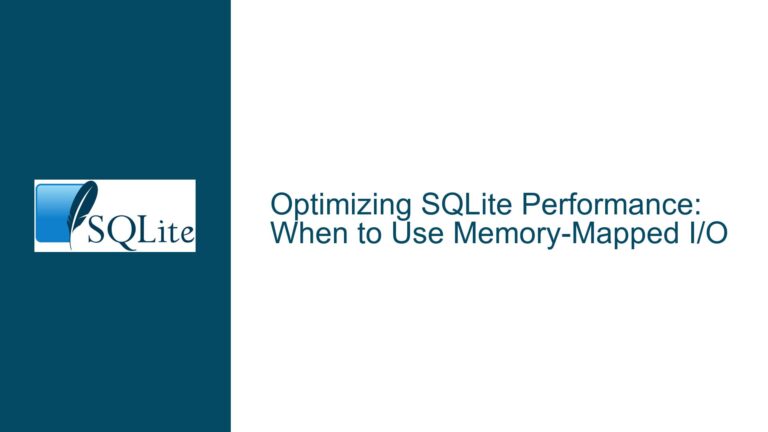Challenges in Implementing Automatic Indexing in SQLite Databases
SQLite’s Current Index Management Capabilities and Limitations
SQLite’s indexing mechanism is a cornerstone of its query optimization strategy, but its approach to index creation and maintenance is deliberately non-automatic. The database engine does not dynamically create or drop indexes based on query patterns, except in narrow scenarios such as enforcing UNIQUE or FOREIGN KEY constraints. This design stems from fundamental trade-offs between performance, storage efficiency, and predictability.
How SQLite Uses Indexes Today
When a query is executed, SQLite’s query planner evaluates available indexes to determine the most efficient access path. This decision relies on statistics collected via the ANALYZE command, which gathers data about table cardinality and index selectivity. However, these statistics only inform the planner’s choices; they do not trigger the creation of new indexes. For example, if a WHERE clause filters on a column without an index, the planner defaults to a full table scan, even if historical query patterns suggest an index would be beneficial.
The .expert command in the SQLite CLI represents the closest built-in tool for automated index recommendations. By simulating hypothetical indexes for a given query, it identifies missing indexes that could improve performance. However, this tool is reactive—it requires explicit invocation and does not integrate with runtime query execution.
The Role of Constraints in Index Automation
SQLite automatically creates indexes for PRIMARY KEY and UNIQUE constraints to enforce entity integrity. Similarly, FOREIGN KEY constraints (when enabled) rely on indexes in the parent table for efficient lookups. These cases are exceptions to SQLite’s hands-off approach, as the indexes serve dual purposes: integrity enforcement and query optimization. However, this automation does not extend to general query performance. For instance, a WHERE clause on a non-indexed column in a large table will not prompt SQLite to create an index, even if repeated queries suggest it would be advantageous.
Why Full Automation Is Absent
The absence of automatic index management in SQLite is intentional. Indexes impose ongoing costs: they consume storage, slow down INSERT/UPDATE/DELETE operations, and require maintenance during schema changes. Automating index creation would necessitate real-time cost-benefit analysis, weighing the immediate overhead of index creation against uncertain future query benefits. This complexity is compounded by the fact that optimal indexing strategies depend on dynamic factors like data distribution, query frequency, and update patterns—variables that are difficult to generalize across applications.
Key Obstacles to Dynamic Index Creation and Maintenance
Implementing automatic indexing in SQLite faces three interrelated challenges: the retrospective nature of index utility, the combinatorial explosion of possible indexes, and the inherent trade-offs between read and write performance.
Retrospective Utility of Indexes
An index’s value is determined by how frequently it accelerates future queries, a metric that is only knowable in hindsight. For example, an index on a last_login column might be invaluable for a monthly user activity report but superfluous for daily operations. SQLite cannot predict which indexes will be needed for ad hoc or infrequent queries, such as emergency data retrievals (e.g., "find all transactions in the last 5 minutes during a system outage"). This uncertainty makes it risky to automatically drop indexes deemed "unused," as their absence could cripple critical but rare operations.
Combinatorial Index Explosion
A table with N columns has 2^N possible single-column and composite indexes (considering column permutations). For a table with 10 columns, this results in 1,023 potential indexes—a clearly impractical number. While covering indexes (indexes that include all columns referenced in a query) can reduce the need for multiple indexes, they still require careful design. Automatic index management would need heuristic rules to prioritize index candidates, such as favoring columns frequently used in WHERE clauses or JOIN conditions. However, even sophisticated heuristics might fail to account for edge cases, such as queries requiring compound sorting (ORDER BY date, user_id).
Write Performance Degradation
Every index added to a table increases the overhead of write operations. When a row is inserted or updated, all associated indexes must be modified. In write-heavy applications, this can lead to significant latency. For example, a table with five indexes might see insert operations take five times longer than an identical table without indexes. Automatic index creation could inadvertently degrade overall system performance if it prioritizes read optimization without considering write throughput.
Statistical Limitations
SQLite’s ANALYZE command collects statistics on index selectivity and table cardinality, which inform the query planner’s decisions. However, these statistics are static snapshots and do not adapt to evolving data distributions. An automatically managed indexing system would require continuous statistical analysis, introducing runtime overhead. Moreover, statistical sampling might miss rare but important data patterns, leading to suboptimal index choices.
Practical Strategies for Index Management in SQLite
Given the limitations of automatic indexing, developers must adopt a deliberate, evidence-based approach to index design. Below are actionable strategies for optimizing index usage while mitigating risks.
Leverage SQLite’s Built-in Tooling
Use
EXPLAIN QUERY PLANfor Insight
Before optimizing, analyze how SQLite executes a query. TheEXPLAIN QUERY PLANcommand reveals whether the query planner is using an index, performing a full table scan, or using a covering index. For example:EXPLAIN QUERY PLAN SELECT * FROM orders WHERE customer_id = 123;If the output includes
SCAN TABLE orders, it indicates no suitable index exists forcustomer_id.Simulate Indexes with
.expert
The.expertcommand in the SQLite CLI recommends indexes for specific queries. For instance:.expert SELECT * FROM invoices WHERE status = 'pending' AND due_date < '2023-10-01';This generates hypothetical indexes and estimates their impact. Developers can then evaluate whether the suggested indexes justify their storage and maintenance costs.
Manual Index Optimization Workflow
Identify High-Impact Queries
Focus on queries that are executed frequently, handle large datasets, or are critical to application responsiveness. Tools like the SQLite Trace API can log queries for analysis.Analyze Data Access Patterns
Determine which columns are used in:WHEREclauses (equality, range conditions)JOINconditionsORDER BY/GROUP BYclauses
Prioritize indexes on columns that appear in these contexts.
Test Index Efficacy
Create a candidate index and measure its impact using realistic workloads. For example:CREATE INDEX idx_orders_customer ON orders(customer_id);Re-run the query with
EXPLAIN QUERY PLANto confirm the index is used. Monitor write performance to ensure the index does not degradeINSERT/UPDATEoperations.Prune Redundant Indexes
Use thesqlite_stat1table to identify unused or redundant indexes. For instance, if an index on(A, B)exists, an index on(A)may be redundant because the composite index can service queries filtering onAalone.
Mitigating Automatic Indexing Pitfalls
Partial Indexes for Targeted Optimization
SQLite supports partial indexes, which only include a subset of rows. This reduces index size and maintenance overhead. For example:CREATE INDEX idx_active_users ON users(email) WHERE is_active = 1;This index would only cover active users, making it smaller and faster to update.
Covering Indexes to Avoid Lookups
Design indexes that include all columns needed by a query, eliminating the need to access the main table. For example:CREATE INDEX idx_covering_orders ON orders(customer_id, order_date, total_amount);A query selecting
customer_idandtotal_amountwith aWHEREclause onorder_datecould be satisfied entirely by this index.Benchmarking Under Realistic Workloads
Simulate production-like conditions when testing indexes. Use tools like the SQLite Benchmark Suite to measure throughput under mixed read/write loads. Adjust indexes iteratively based on performance metrics.
When to Avoid Indexing
- Small Tables: Tables with fewer than 100 rows often perform better with full scans due to index overhead.
- High-Write Environments: If a table is updated more frequently than queried, indexes may degrade overall performance.
- Volatile Columns: Indexing columns with highly volatile values (e.g.,
last_updated) can lead to frequent index rebuilds.
Future Directions and Community Tools
While SQLite itself is unlikely to adopt full automatic indexing, third-party tools can bridge the gap. For example, a script could:
- Capture query patterns from application logs.
- Use
.expertto generate index recommendations. - Apply indexes during maintenance windows.
Such tools would require safeguards to prevent over-indexing, such as whitelisting critical queries or setting storage budgets.
In conclusion, while automatic indexing remains an aspirational goal, SQLite’s current tools and thoughtful manual optimization provide a robust framework for achieving high performance. Developers must balance index benefits against their costs, using empirical data to guide decisions.
